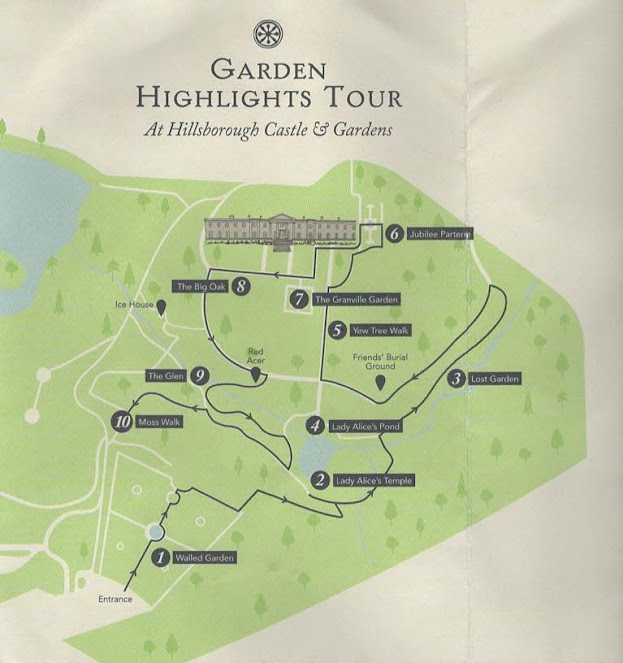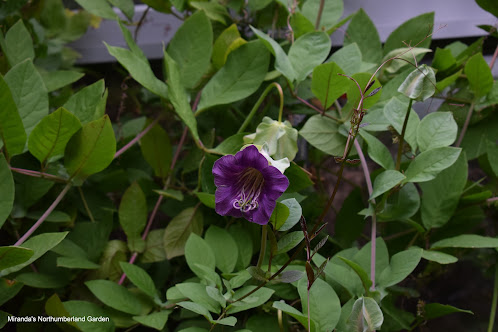In
mid-August T and I popped over to Northern Ireland for a long weekend, when we
left the temperature here in Northumberland was in the 30s however, when we
returned four days later the heatwave had gone and the temperature had
plummeted to the 20s – autumn was definitely in the air.
In Northern
Ireland we noticed that the country had clearly not experienced the scorching
temperatures or lack of rain which had beset mainland England, the country was,
in fact, was lush and verdant.
Whilst there we spent a
day visiting Royal Hillsborough Castle and Gardens which is managed by the Historic
Royal Palaces. Built in around 1760 the Castle was designed
to be a grand Georgian country house for the Earls of Downshire (the Hill
family). It passed down to successive
Marquesses and in 1922 the 6th Marquis sold it to the British government.
This created a home and office for the Governor of Northern Ireland following
the Anglo-Irish Treaty of 1921. The official HRP
website tells me that “Hillsborough Castle has
been a grand family home and is now the official home of the Secretary of State
for Northern Ireland, and a royal residence. Members of the Royal Family stay
at Hillsborough when visiting Northern Ireland.
Viewed by some as a politically neutral venue, Hillsborough
has played an important role in the Peace Process in Northern Ireland since the
1980s. In 2014, Historic Royal Palaces
took over the running of Hillsborough Castle and Gardens and began an
ambitious project to restore the house and gardens to its former glory”.
T and I thoroughly enjoyed
our day exploring the gardens and as I thought the grounds are so beautiful I
wanted to share the day with you so have put together this tour which follows
our footsteps.
We
decided to follow the Garden Highlights Tour as recommended by the head gardener, Claire
Woods.
This self-guided tour starts in the
Walled Garden which covers four acres and dates back to the 18th
century. Trained fruit trees enjoy the warmth from the wall red brick walls.
The garden has been arranged in a traditional layout of rectangular beds bounded by a network of straight
paths, it’s a fine example of a working
and productive garden.
At the far end
of the Garden and built into the perimeter wall, stands the gardeners’ potting
shed. It is jammed packed with
horticultural implements, the design of which is familiar to modern day
gardeners as similar tools are still in use today.
Exiting the
Walled Kitchen Garden through the potting shed we walked through an area of
mature woodland and arrived at Lady Alice’s Temple. This lovely structure was given as a wedding gift to Lady Alice Hill by
her brother, the 5th Marquess of Downshire in 1867. I love garden structures such as these,
for their architecture and for the way they sit in the landscape, they are a lovely place for rest and for quiet contemplation.

From our seats
in the Temple, we look across Lady Alice’s pond to the Yew Tree Walk and to Royal
Hillsborough Castle in the distance.
To our left is the
Moss Walk, shaded by Lime trees; the mosses growing under these trees are a
unique environment and need to be protected so understandably nobody is allowed
to walk its length. The walk struck me
as a very peaceful place to sit and ponder.

Turning right
from Lady Alice’s Temple we walked along a stream which forms the backbone of
The Lost Garden. According to the guide
in the 1830s the stream was enhanced with waterfalls, bridges and exotic
plantings in order to give a southern hemisphere feel to this area of the
garden.
When we
visited, it was in the process of being renovated, with new plantings and careful
prunings in order to bring it back to its former glory.
The path around
the Lost Garden leads one along the south then north banks of the stream .
Leaving the
Lost Garden behind us, we followed the foothpath round to the right and started
climbing the hill on Yew Tree Walk, this walk follows the course of the
original road to the village of Moira. In
between the large yew trees wild flowers were flourishing.
The flowers were
attracting many different types of pollinators.
At the end of
the Yew Tree Walk stood Royal Hillsborough Castle, we climbed a flight of stone
steps and walked to the right hand side of the Castle. To the south and down
stone steps lay the Jubilee Garden, redesigned and renamed in 2012 for the Diamond Jubilee.
Bounded by large
yew trees and with a central ornamental pond, this pretty garden had beds edged
in clipped box punctuated with topiared finials of box; in each island bed grow
sambucus nigra, white/pink Phlox
paniculata and what I think are cardoons.
The white to purple tones of these perennials gave a calming feel to
this part of the garden.
Retracing our
steps around to the west side of the Castle, behind black wrought iron
railings, we found the beautiful Granville Garden. Created in the 1940s and 1950s by Lady Rose Bowes-Lyon, aunt
to the then-Queen. Upon marrying the Earl of Granville Lady Bowes-Lyon became
Lady Granville. The Earl of Granville
was Governor of Northern Ireland from 1945 until 1952 and the couple lived here
during that time. Lady Granville loved
gardening and during her time here spent the time developing this space.
The Granville
Garden has central beds planted with hybrid tea, climbing and scrambling roses whilst
in the outer beds grow herbaceous perennials.
Back on the
main footpath and tucked away in a corner on the north side of Royal
Hillsborough I found a pretty little glasshouse, packed full of tender little
gems, all growing away happily; I spotted succulents, pelargoniums and
passiflora all basking in the warm sunlight.
Heading west we
walked away from the Castle and followed a footpath edged with specium trees. The path eventually lead us to the Glen, here
the tour follows the same stream which we had walked beside in The Lost Garden. The stream tumbles and flows past some fine
examples of acers before eventually emptying into the lake.
By now it was
pouring with rain as can be seen in this photograph - the rain drops were
landing on my camera lens.
Having walked
the length of the Glen we retraced the course of the stream on the opposite
bank until we reached Lady Alice’s pond and headed for the exit via the Walled
Kitchen Garden. Our visit ended in the
café where we contemplated our enjoyable visit with tea and delicious scones.
Funnily
enough, a few years back I had visited both Highgrove Garden and Dumfries House
and Garden. To me Royal Hillsborough is very
reminiscent in style and quality of those two incredible gardens; in all three
gardens each area had been laid out with so much thought and with the utmost
attention to detail. Planting choices
were exquisite and colour palettes could not be improved upon, and each section
of garden was to me, perfection.
I
highly recommend anyone should visit Royal Hillsborough Castle and Gardens as
they will certainly not be disappointed.














































